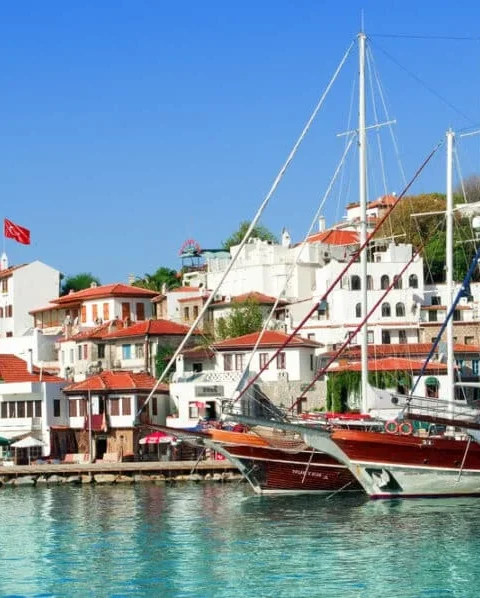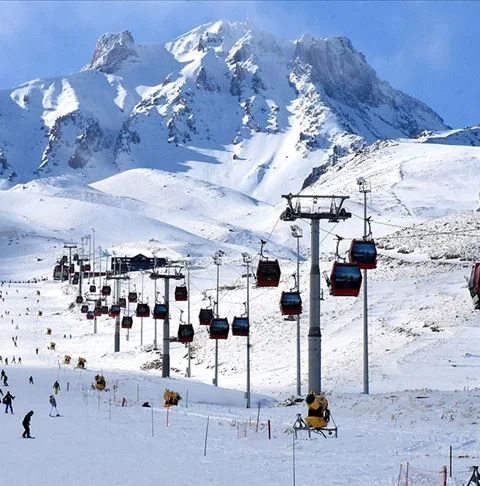The ancient town of Çatalhöyük appears today as a large hill on the Anatolian plain. However the grass and soil conceal a settlement that was once lived in by 3,500 to 8,000 people more than 9,000 years ago. This concentrated farming community produced exceptional art and architecture for its time,
making it one of the most important archaeological sites in the world.

Catalhoyuk was originally settled approximately 9000 years ago during the Neolithic (New Stone Age). It extended over a massive 13.5 hectares of land, and was occupied for around 1400 years. Over this time period, the town grew as people abandoned old houses, filled them in, and built new ones on top— creating a mound over 21 metres high. The buildings were packed tightly so that there were few or no streets. Instead, people walked across roofs and down ladders into interior spaces.
Each house was probably inhabited by a family of 5 to 10 people. There was a main room for living, craft activities, cooking, eating and sleeping, and there were side rooms for storage and food preparation. The interiors were sometimes decorated with rich art, and the dead were buried under the floors. As Çatalhöyük grew in population, it is likely that its residents began to disperse, ultimately leaving the town for other sites in the vicinity and beyond.
A half century of excavation at Catalhoyuk
After the 1960s excavations ended, work was resumed by Professor Ian Hodder in 1993. He recruited an international group of specialists to continue investigating the details of human life at Çatalhöyük. These experts now visit the site each year from Turkey and dozens of other countries around the world. Hodder’s team aims to advance knowledge not only of the site itself, but of scientific technique, conservation, and the public presentation of archaeology. The excavation is internationally famous due to its large scale and the wealth of information it provides about life in the Neolithic period.

Although the local community has long known of Çatalhöyük, archaeologists learned about it only in
the late 1950s when James Mellaart, David French and colleagues went searching for evidence of farming and major settlement in central Anatolia. With a large team of Turkish labourers and some Turkish and international scholars, Mellaart excavated about 160 buildings between 1961 and 1965 At the same time, he widely publicised the findings, thus launching Catalhoyuk’s world-wide renown.

Most of the findings uncovered at Catalhoyuk over its 50 years of study are housed and displayed in nearby institutions. The artefacts excavated by Mellaart’s team in the 1960s are held by the Museum of Anatolian Civilizations in Ankara. Those excavated more recently by Hodder’s team are held in Konya at the Archaeological Museum.
What is Catalhoyuk ?
The earliest settlement at Çatalhöyük was probably located in a shallow depression on the landscape, surrounded by plains and wetlands rich in resources: reeds (for building and matting), birds and eggs, as well as wild cattle, boar, and deer. Evidence suggests that households cooperated in tending fields (e.g., of cereals) and grazed their sheep and goats around the settlement on slightly raised ground. People also appear to have set up long-distance networks of exchange across the eastern Mediterranean, trading materials like obsidian from Cappadocia and baskets from the Red Sea.

The term ‘Catalhoyuk’ means ‘fork mound,’ probably referring to the fact that the road from the nearby town of Çumra divides here in multiple directions. Çatalhöyük is in fact two separate hills: the East Mound dating from 7400 BC (during the Neolithic period), and the West Mound dating from about 6000 BC (the Chalcolithic period). Over time, it is likely that the population of the East Mound increased to such an extent that people began to move to different locations—the West Mound being one such site. It was once thought that Çatalhöyük represented the first sedentary settlement of people anywhere in the world. We now know that the site was built several thousand years after the emergence of such settlements in the Middle East and after the domestication of plants, sheep and goats. Nevertheless, Çatalhöyük remains unique in having the densest concentration of art and symbolism in the eastern Mediterranean.
What was the role of art and symbolism at Catalhoyuk?
Catalhoyuk has some of the most important art of any archaeological site in the world. This is because the art is very densely concentrated, symbolically complex, and takes many forms: paintings and reliefs, installations, sculpture, incised geometric patterning, clay seals, and figurines. Animals such as wild bulls, rams, deer, vultures, bears and leopards are frequently represented. In many cases, animals and people appear sideby-side in poses that suggest humans are teasing, baiting, or playing with the animals—perhaps to demonstrate their dominance.

Many small figurines have been uncovered at Çatalhöyük in a striking variety of styles and forms, including human, animal, and other types. This diversity in form challenges previous interpretations of the figurines as being representations of a ‘Mother Goddess’ or specifically religious or cult objects. There is no evidence of their purposeful burying or caching, and most were probably made very quickly in domestic environments. Although some may relate to ritual behaviour, the majority of figurines were likely linked to everyday use.
Your Visit
There is a small on-site Visitor Centre, featuring exhibitions and replica artefacts designed by the project’s visualisation team. Your visit around the site itself will be led by a dedicated tour guide or site guard, who will facilitate your entry into both the North and South excavation areas as well as a replica Çatalhöyük house. For health and safety reasons, accessing the site without a guide is strictly prohibited.
It is with regret that the site is not wheelchair accessible. Visitors with mobility or access concerns should Contact Us prior to travel to discuss your trip to site.
Facilities include public restrooms as well as an adjacent café where refreshments and souvenirs can be purchased.
Getting to Catalhoyuk
Çatalhöyük is located 60km to the east of the city of Konya, near the town of Cumra.
By Car
From Konya, take the 715 road towards Karaman.
Drive 60km out of Konya and then at a major crossroads with a roundabout turn left towards Çumra. Çatalhöyük should already be signposted here.
Drive approximately 12km through the village of Içeriçumra until you arrive in Çumra,
When you arrive at the centre of Çumra turn left in front of a modern mosque.
Continue for 500m and then turn right followed by an immediate left to cross the railway track.
After crossing the railway, continue for 20km keeping the river (and the big irrigation canal) on your left.
You will eventually see the mound and site buildings on your right. Turn right into the access road and park by the custodian’s house.
*A suitable road map of the region should also be taken as a precaution.
By taxi
Taxis are available from Konya.
By bus
Buses are available from Konya.












